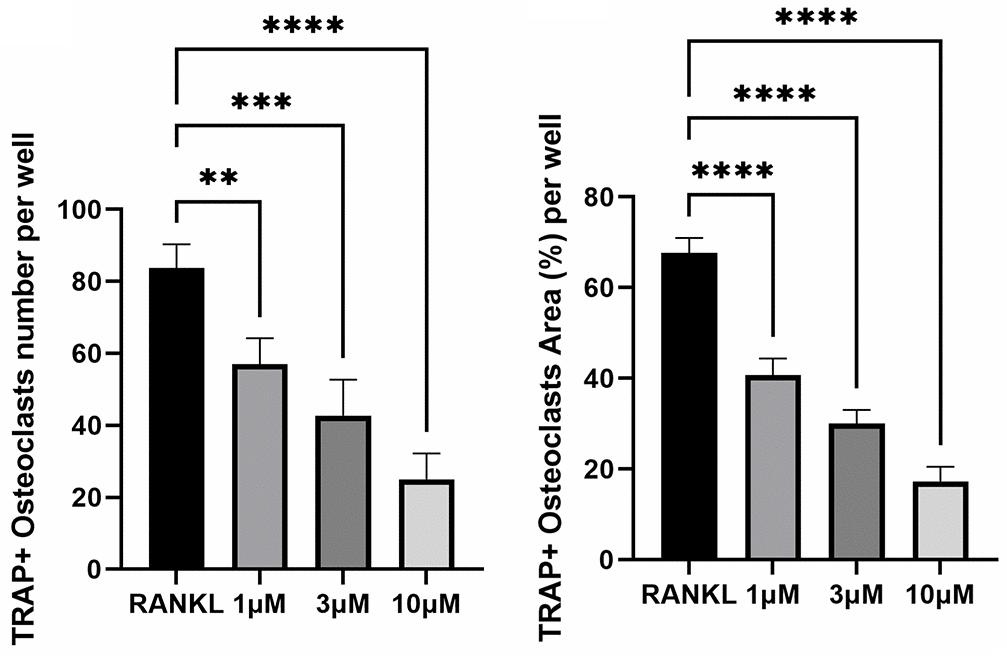A team of researchers has found that corylin, a compound previously investigated for its anti-senesence properties, is effective against osteoporosis in a mouse model.
A return to a well-known compound
Corylin is a compound that was first discovered in Psoralea corylifolia, a plant commonly used in Chinese traditional medicine. This is far from the first investigation into corylin: this compound has been found to be effective against a few aspects of aging in cellular, yeast, and mouse models. These researchers also cite prior studies demonstrating its potential utility against inflammation [1], oxidative stress [2], and cancer [3].
For this study, however, their main interest is its effects on bone. Corylin has been previously reported to encourage bone-building cells (osteoblasts) [4] while suppressing bone-consuming cells (osteoclasts) [5]. This might fight back against osteoporosis, a condition in which osteoclasts run wild and consume substantial amounts of bone material, rendering bones brittle and falls potentially deadly.
Discourages osteoclasts at every level
This study’s experiments began with bone marrow macrophages derived from young mice. These cells are known to differentiate into osteoclasts when treated with the compound RANKL. However, co-treatment with corylin blocked most of this differentiation in a dose-dependent manner.

Similarly, treating existing osteoclasts with corylin decreased their capabilities, preventing them from creating deep pits when placed on bone plates. These results were corroborated with a gene expression analysis, which reported that genes related to osteoclast differentiation and function were inhibited by corylin. Additionally, the osteoclast differentation process, in which pre-osteoclasts migrate and fuse into osteoclasts, was disrupted. This was found to be accompanied by a reduction in mitochondrial mass and number.
Following these results, the researchers continued with a mouse study. 12-week-old female mice had their ovaries removed, which leads to overproduction of osteoclasts and severe osteoporosis. Treating this population with corylin for four weeks after the surgery reduced much of the osteoclast production and bone loss, although not to the level of the control group.

These results, while initially promising, were not conducted in wild-type mice or on cells derived from human beings. Given the amount of information published on corylin, more comprehensive animal and human trials are warranted to determine its side effects and prove or disprove its efficacy against multiple conditions, including osteoporosis. The precise mechanism of action should also be investigated.
Literature
[1] Chen, C. C., Li, H. Y., Leu, Y. L., Chen, Y. J., Wang, C. J., & Wang, S. H. (2020). Corylin inhibits vascular cell inflammation, proliferation and migration and reduces atherosclerosis in ApoE-deficient mice. Antioxidants, 9(4), 275.
[2] Wei, S. M., Yan, Z. Z., & Zhou, J. (2011). Psoralea corylifolia protects against testicular torsion/detorsion-induced ischemia/reperfusion injury. Journal of ethnopharmacology, 137(1), 568-574.
[3] Lin, Z., Liao, L., Zhao, S., Gu, W., Wang, G., Shen, Z., … & Yan, T. (2023). Corylin inhibits the progression of Non-small cell lung cancer cells by regulating NF-κB signaling pathway via targeting p65. Phytomedicine, 110, 154627.
[4] Yu, A. X. D., Xu, M. L., Yao, P., Kwan, K. K. L., Liu, Y. X., Duan, R., … & Tsim, K. W. K. (2020). Corylin, a flavonoid derived from Psoralea Fructus, induces osteoblastic differentiation via estrogen and Wnt/β‐catenin signaling pathways. The FASEB Journal, 34(3), 4311-4328.
[5] Yu, A. X. D., Xiao, J., Zhao, S. Z., Kong, X. P., Kwan, K. K. L., Zheng, B. Z. Y., … & Tsim, K. W. K. (2021). Biological evaluation and transcriptomic analysis of Corylin as an inhibitor of osteoclast differentiation. International Journal of Molecular Sciences, 22(7), 3540.
View the article at lifespan.io









































